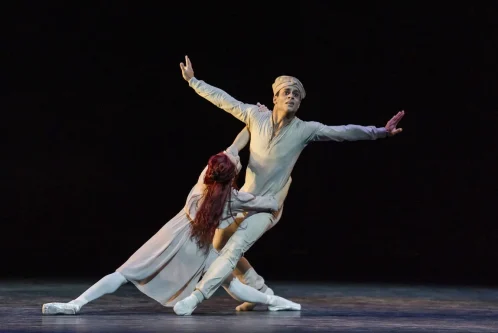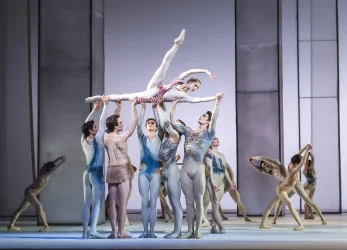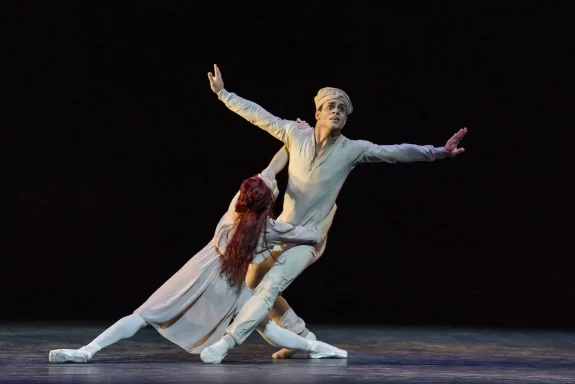 United Kingdom MacMillan Celebrated – Danses concertantes, Different Drummer and Requiem: Dancers of The Royal Ballet, Isabela Díaz (soprano), Josef Jeongmeen Ahn (baritone), Chorus and Orchestra of the Royal Opera House / Koen Kessels (conductor). Broadcast live (directed by Ross MacGibbon) from the Royal Opera House, Covent Garden, to Cineworld Basildon, Essex, 9.4.2024. (JPr)
United Kingdom MacMillan Celebrated – Danses concertantes, Different Drummer and Requiem: Dancers of The Royal Ballet, Isabela Díaz (soprano), Josef Jeongmeen Ahn (baritone), Chorus and Orchestra of the Royal Opera House / Koen Kessels (conductor). Broadcast live (directed by Ross MacGibbon) from the Royal Opera House, Covent Garden, to Cineworld Basildon, Essex, 9.4.2024. (JPr)

It is Kenneth MacMillan’s choreographic legacy – notably for The Royal Ballet – which is being celebrated here rather than any particular anniversary; with his centenary of his birth not due until 2029. I am more familiar with his full-length ballets, such as Romeo and Juliet, Manon and Mayerling, and I have always enjoyed – in different ways – shorter works such as Song of the Earth and Elite Syncopations, whilst being totally antipathetic, for reasons not to go into here, to The Judas Tree.
Put together in an oddly downbeat triple bill are his Danses concertantes (created in 1955 for Sadler’s Wells Ballet Theatre, which became The Birmingham Royal Ballet), Requiem (first danced by Stuttgart Ballet in 1976) and the 1984 Different Drummer for The Royal Ballet.
Laura Morera who oversees the choreographer’s ballets for the MacMillan Estate explained how ‘There was so much work of MacMillan that we need to be open to see; the sharpness, the quirkiness, the technicality of Danses concertantes; into the darkness and the worst of humanity in Different Drummer; and then we have the purity and spirituality of Requiem and that’s all done through design, through music, and through dance: three languages come together constantly pushing the artform. It’s particularly incredible’.
I do think audiences in the cinema had the best view (thanks to Ross MacGibbon’s close-up camerawork) than anyone ever would in the opera house so the three works were captivating, disturbing and moving, by turns. With one of its time (Danses concertantes), a second (possibly) before its time (Different Drummer) and the third timeless (Requiem).
Unfortunately – and possibly something many are reluctant to admit – putting three creations by the same choreographer together shows up some sameness in that ‘dance language’: arms raised above heads, bodies entwined around each other or otherwise sweeping (!) the floor were repeated and repeated, amongst other images such as a female dancer held upside down as if martyred on a cross. Of course, this was MacMillan’s evening, though in general different choreographers with often their own unique languages makes for a more varied programme.
Danses concertantes was MacMillan’s first professional commission and the first collaboration with his longtime designer, the late Nicholas Georgiadis. The costumes are vividly colourful with some bizarre headpieces for both men (spikes) and women (eagles) which looked to be from Germany c.1900. Georgiadis’s, I believe, equally colourful (Ballet Russes-inspired?) set was lost in shadow on the cinema screen. MacMillan’s fleet-footed choreography to some, unfamiliar to me, jazzy Stravinsky’s music required the dancers – we were told – to constantly ‘count’. Most in Danses concertantes were doing just that rather than moving instinctively, so maybe as a result of that synchronicity in all the arabesques, changes of direction and pointed fingers was not always 100%. Totally absolved of any criticism was Valentino Zucchetti who showed those around him how it should be done and the enchanting Isabella Gasparini in the leading female role. Unfortunately, Danses concertantes does outstay its welcome and just as you think it is finished it starts up again for a brief coda.
Possibly those pointed fingers came from the Fairy of the Golden Vine in Sleeping Beauty and certainly Petrushka heavily influenced MacMillan’s Woyzeck in Different Drummer. The eponymous puppet considers himself betrayed by the woman he loves and through jealousy kills his rival. Add in some human experimentation and PTSD and clearly Different Drummer is MacMillan’s Petrushka. Nominally it is MacMillan’s version of Georg Buchner’s 1913 Woyzeck (which he began earlier in the nineteenth century) and danced to Anton Webern’s Passacaglia for orchestra, Op.1 and Arnold Schoenberg’s Verklärte Nacht, both deeply expressive scores. I have seen Alban Berg’s opera version but certainly I – as everyone in the Cineworld Basildon possibly? – could have done with an explanation of the dramatic and traumatic story we were about to see unfold.

On an almost bare stage Different Drummer is very grey and grim, and populated by spiked-helmeted soldiers. Woyzeck, who is one of them, is abused, degraded and cuckolded at the hands of Thomas Whitehead’s brutal Captain (who terrifyingly – and silently – barks out his orders); Kevin Emerton’s ghoulish Doctor who experiments on him; and Francisco Serrano’s vainglorious Drum Major who takes advantage of Woyzeck’s lonely common-law wife, Marie (who has born Woyzeck an illegitimate child). With his wracked body, distorted flailing movement, and jumps backward, Woyzeck is a tortured and broken Petrushka-like soul, and his inevitable recourse will involve murder and his eventual suicide (in a bath). It all appears to take an emotional toll on the remarkable Marcelino Sambé, and his equal in the acting-stakes is Francesca Hayward as the suffering, downtrodden, abandoned and guilt-ridden wife. (I cannot immediately recall a better performance from either of them.) Marie develops a Mary Magdalene fixation at least in Woyzeck’s fevered mind – his hallucinations are a feature of Different Drummer – and using her long red hair she is shown drying the feet of a Christ-like figure (Téo Dubreuil with a crown of thorns). If the subject matter wasn’t off-putting enough, I wonder what some at the cinema made of the graphic – if fully clothed – sex Marie and the Drum Major engage in.
Finally, Requiem, performed against some translucent columns from Yolanda Sonnabend and in her rather unflattering figure-hugging lycra costumes for many of the dancers, as well as a white shift for the leading female dancer and a loincloth for the bare-chested (Christ-like again) William Bracewell. Much of the inspiration for MacMillan’s choreography and the striations on the costumes comes from the works of William Blake and the ballet was a tribute to fellow choreographer John Cranko, who had died suddenly in 1973.

The dancers enter (as grieving mourners?) pummelling the air with their fists and in the Introit and Kyrie the always elegant Sarah Lamb gets raised aloft as if venerated, was I right (!) in recalling The Rite of Spring ballet here? She gets two duets with the leading men in the Offertorium (William Bracewell) and the Sanctus (Lukas B. Brændsrød) who have their own tormented solos and Lamb’s own eloquent solo is to the prayerful Pie Jesu. Melissa Hamilton caught the eye in the Agnus Dei, though Requiem was exceptionally well danced by the entire company. It all ends with In Paradisum where everyone gathers round a huge pool of light as if bearing witness to a soul’s (Cranko’s?) departure to heaven before a serene ending. Poignant seems the most appropriate word for MacMillan’s Requiem though it will also make you reflect not only on any personal grief but also our current troubled world. In hindsight, perhaps it might have been better to end this ‘celebration’ in more optimistic mood.
Of course the sound we heard was though high quality loudspeakers but has the Orchestra of the Royal Opera House ever played better for ballet? They were superbly conducted by Koen Kessels in music by such eclectic composers as Stravinsky, Webern, Schoenberg and finally Fauré, where Jette Parker Artists Isabela Díaz (soprano), Josef Jeongmeen Ahn (baritone) and The Royal Opera Chorus deserve the highest praise too.
Jim Pritchard
Danses concertantes
Music – Igor Stravinsky
Designer – Nicholas Georgiadis
Staging – Laura Morera
Dancers – Isabella Gasparini, Giacomo Rovero, Sae Maeda, Valentino Zucchetti, Ashley Dean, Taisuke Nakao, Liam Boswell, Marco Masciari, Isabel Lubach, Nadia Mullova-Barley, Katharina Nikelski, Maddison Pritchard, Julia Roscoe, Charlotte Tonkinson
Different Drummer
Music – Anton Webern, Arnold Schoenberg
Set designer – Kenneth MacMillan
Costume designer – Yolanda Sonnabend in association with Peter Farley Staging – Gary Harris
Woyzeck – Marcelino Sambé
Marie – Francesca Hayward
Drum Major – Francisco Serrano
Andres – Benjamin Ella
Captain – Thomas Whitehead
Doctor – Kevin Emerton
A Soldier – Téo Dubreuil
Soldiers – Harris Bell, Harry Churches, Joshua Junker, Harrison Lee
Requiem
Music – Gabriel Fauré
Designer – Yolanda Sonnabend in association with Peter Farley
Staging – Christopher Saunders
Dancers included – Sarah Lamb, Lukas B. Brændsrød, William Bracewell, Melissa Hamilton, Joseph Sissens, Mica Bradbury, Ashley Dean, Meaghan Grace Hinkis, Leo Dixon, Téo Dubreuil, Valentino Zucchetti
Soprano – Isabela Díaz
Baritone – Josef Jeongmeen Ahn
The Royal Opera Chorus (chorus director – William Spaulding)
